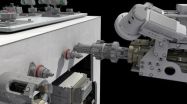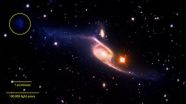(Press-News.org) NASA's Aqua satellite looked at Cyclone Narelle in visible and infrared light to understand the behavior of the storm. NASA's MODIS and AIRS instruments provided those data, respectively, and they showed that Narelle is gaining strength as it approaches the northern coast of Western Australia.
Watches and Warnings are posted for the western coast of Western Australia over the next several days as Narelle continues to move on a southerly track, where it is expected to remain at sea, but parallel the coast.
Current Australian warnings include: a Cyclone Warning is in effect for coastal areas from Whim Creek to Coral Bay, including Karratha, Dampier, Onslow and Exmouth. A Cyclone Watch is in effect for coastal areas from Coral Bay to Cape Cuvier. A Blue alert is in effect for the coastal and island communities from Whim Creek to Mardie, including Wickham, Roebourne, Point Sampson, Karratha and DampiFor updated warnings and watches, visit the Australian Bureau of Meteorology web page: http://www.bom.gov.au/australia/warnings/index.shtml.
When NASA's Aqua satellite passed over Narelle on Jan. 9 at 1811 UTC (1:11 p.m. EST/2:11 a.m. on Jan. 10, local time, Perth, Australia), the Atmospheric Infrared Sounder (AIRS) instrument captured data on the storm in infrared light. Infrared light shows temperature, and cloud top temperatures can indicate if clouds are reaching higher in the atmosphere (strengthening) or lower (weakening). AIRS data showed that the largest area of powerful thunderstorms were around the center, north and northwest of the center of circulation, an indication of where the heaviest rain was falling.
Another that flies aboard NASA's Aqua satellite called the Moderate Resolution Imaging Spectroradiometer (MODIS) instrument captured a visible image of Tropical Cyclone Narelle as it was approaching the northern coast of Western Australia. The image was taken on Jan. 10, 2013 at 0625 UTC (1:25 a.m. EST/2:25 p.m. local time, Perth, Australia). The MODIS image revealed that Narelle developed the signature shape of a tropical cyclone with a tight rounded center and bands of thunderstorms wrapping into the center.
On Jan. 10 at 1500 UTC (10 a.m. EST/11 p.m. local time, Perth), Tropical Cyclone Narelle had maximum sustained winds near 80 knots (92 mph/148.2 kph). It was centered near 16.5 south latitude and 114.7 east longitude, about 370 nautical miles north of Learmonth, Australia. Narelle has been moving south-southwest at 10 knots (11.5 mph/18.5 kph). Narelle is churning up rough seas, as high as 32 feet (9.7 meters), which will likely cause coastal erosion and flooding. Narelle is expected to continue moving to the south-southwest toward Northwest Cape and gradually intensify.
Infrared imagery, such as what AIRS provides shows that a new feeder band of thunderstorms has formed to the south of the center. Infrared data showed that cloud tops around the center have cooled, indicating convection (rising air forming the thunderstorms that make up the cyclone) has strengthened, and cloud tops are higher and the storms more powerful. Microwave satellite data, which can see through clouds, showed that an eye was forming in the center. The JTWC forecasters call for Narelle to continue intensifying as it moves south, and peak around 115 knots (132.3 mph/213 kph) sometime on Jan. 12 before weakening again.
New forecast guidance from the Joint Typhoon Warning Center (JTWC) now calls for the west coast of Western Australia to experience Tropical Cyclone Narelle's rainfall, gusty winds and rough surf. The JTWC forecast now takes Narelle close to the coast from north of Learmonth to the peninsula south of Perth, where it is now expected to make landfall in the South West region of Western Australia on Jan. 15 after tracking south through Geographe Bay.
INFORMATION:
NASA sees Tropical Cyclone Narelle approaching Western Australia coast
2013-01-11
ELSE PRESS RELEASES FROM THIS DATE:
Surgical technique spots cancer invasion with fluorescence
2013-01-11
One of the greatest challenges faced by cancer surgeons is to know exactly which tissue to remove, or not, while the patient is under anesthesia. A team of surgeons and scientists at University of California, San Diego School of Medicine have developed a new technique that will allow surgeons to identify during surgery which lymph nodes are cancerous so that healthy tissue can be saved. The findings will be published in the January 15 print edition of Cancer Research.
"This research is significant because it shows real-time intraoperative detection of cancer metastases ...
Scripps Florida scientists uncover potential drug target to block cell death in Parkinson's disease
2013-01-11
JUPITER, FL, January 10, 2013 – Oxidative stress is a primary villain in a host of diseases that range from cancer and heart failure to Alzheimer's disease, Amyotrophic Lateral Sclerosis and Parkinson's disease. Now, scientists from the Florida campus of The Scripps Research Institute (TSRI) have found that blocking the interaction of a critical enzyme may counteract the destruction of neurons associated with these neurodegenerative diseases, suggesting a potential new target for drug development.
These findings appear in the January 11, 2013 edition of The Journal of ...
NASA's robotic refueling demo set to jumpstart expanded capabilities in space
2013-01-11
In mid-January, NASA will take the next step in advancing robotic satellite-servicing technologies as it tests the Robotic Refueling Mission, or RRM aboard the International Space Station. The investigation may one day substantially impact the many satellites that deliver products Americans rely upon daily, such as weather reports, cell phones and television news.
During five days of operations, controllers from NASA and the Canadian Space Agency will use the space station's remotely operated Special Purpose Dexterous Manipulator, or Dextre, robot to simulate robotic ...
Study finds poorer outcomes for obese patients treated for lumbar disc herniation
2013-01-11
Rosemont, Ill. – While obese patients are more likely to have surgical treatment for lumbar disc herniation – a slipped or ruptured disc – than nonobese patients, obesity increases operative time, blood loss and length of hospital stay, according to new research published in the January 2013 Journal of Bone and Joint Surgery (JBJS). Overall, obese patients had poorer outcomes with surgical and nonsurgical treatments for lumbar disc herniation than nonobese patients.
The study included 854 nonobese patients with a Body Mass Index (BMI) of less than 30 kg/m², and 336 ...
Virus caught in the act of infecting a cell
2013-01-11
AUSTIN, Texas — The detailed changes in the structure of a virus as it infects an E. coli bacterium have been observed for the first time, report researchers from The University of Texas at Austin and The University of Texas Health Science Center at Houston (UT Health) Medical School this week in Science Express.
To infect a cell, a virus must be able to first find a suitable cell and then eject its genetic material into its host. This robot-like process has been observed in a virus called T7 and visualized by Ian Molineux, professor of biology at The University of Texas ...
Stem cells found to heal damaged artery in lab study
2013-01-11
Scientists at the Texas Biomedical Research Institute have for the first time demonstrated that baboon embryonic stem cells can be programmed to completely restore a severely damaged artery. These early results show promise for eventually developing stem cell therapies to restore human tissues or organs damaged by age or disease.
"We first cultured the stem cells in petri dishes under special conditions to make them differentiate into cells that are the precursors of blood vessels, and we saw that we could get them to form tubular and branching structures, similar to ...
UC Davis study deflates notion that pear-shaped bodies more healthy than apples
2013-01-11
(SACRAMENTO, Calif.) — People who are "apple-shaped" — with fat more concentrated around the abdomen — have long been considered more at risk for conditions such as heart disease and diabetes than those who are "pear-shaped" and carry weight more in the buttocks, hips and thighs.
But new research conducted at UC Davis Health System published in The Journal of Clinical Endocrinology and Metabolism provides further evidence that the protective benefits of having a pear-body shape may be more myth than reality. The journal article posted online January 10 and will appear ...
Oxygen to the core
2013-01-11
LIVERMORE, Calif. -- An international collaboration including researchers from Lawrence Livermore National Laboratory has discovered that the Earth's core formed under more oxidizing condition's than previously proposed.
Through of series of laser-heated diamond anvil cell experiments at high pressure (350,000 to 700,000 atmospheres of pressure) and temperatures (5,120 to 7,460 degrees Fahrenheit), the team demonstrated that the depletion of siderophile (also known as "iron loving") elements can be produced by core formation under more oxidizing conditions than earlier ...
NASA's GALEX reveals the largest-known spiral galaxy
2013-01-11
The spectacular barred spiral galaxy NGC 6872 has ranked among the biggest stellar systems for decades. Now a team of astronomers from the United States, Chile and Brazil has crowned it the largest-known spiral, based on archival data from NASA's Galaxy Evolution Explorer (GALEX) mission, which has since been loaned to the California Institute of Technology, Pasadena
Measuring tip-to-tip across its two outsized spiral arms, NGC 6872 spans more than 522,000 light-years, making it more than five times the size of our Milky Way galaxy.
"Without GALEX's ability to detect ...
Saliva gland test for Parkinson's shows promise, study finds
2013-01-11
PHOENIX — Described as a "big step forward" for research and treatment of Parkinson's disease, new research from Mayo Clinic in Arizona and Banner Sun Health Research Institute suggests that testing a portion of a person's saliva gland may be a way to diagnose the disease. The study was released today and will be presented at the American Academy of Neurology's annual meeting in San Diego in March.
"There is currently no diagnostic test for Parkinson's disease," says study author Charles Adler, M.D., Ph.D., a neurologist with Mayo Clinic in Arizona. "We have previously ...





